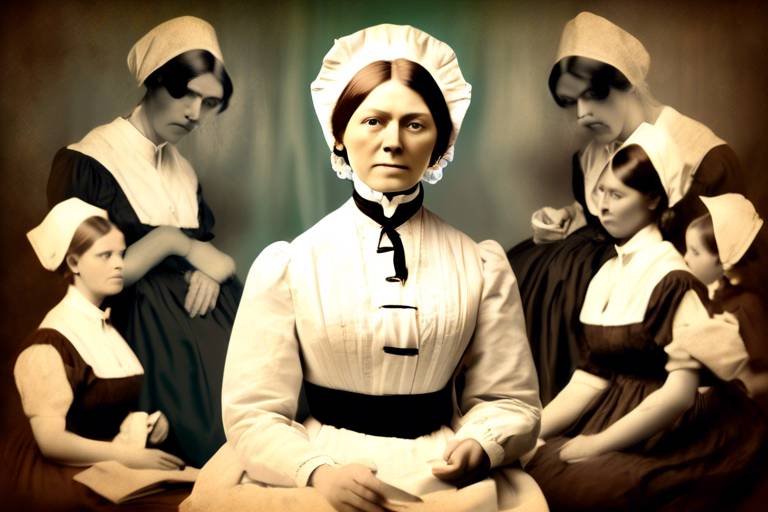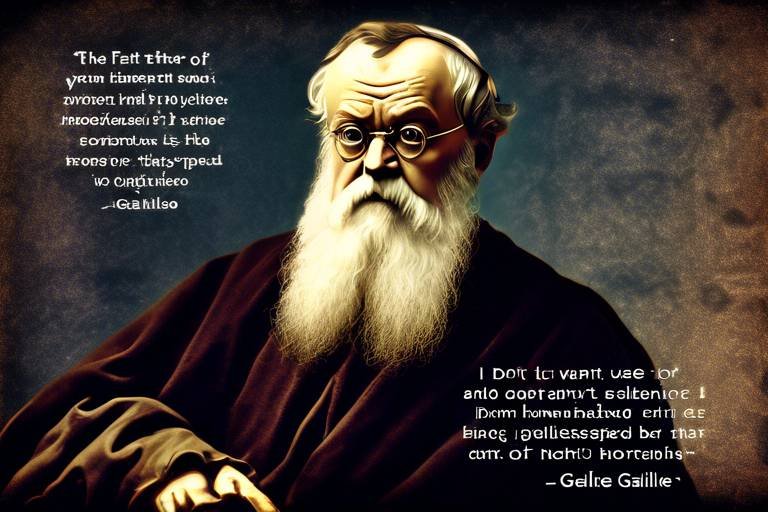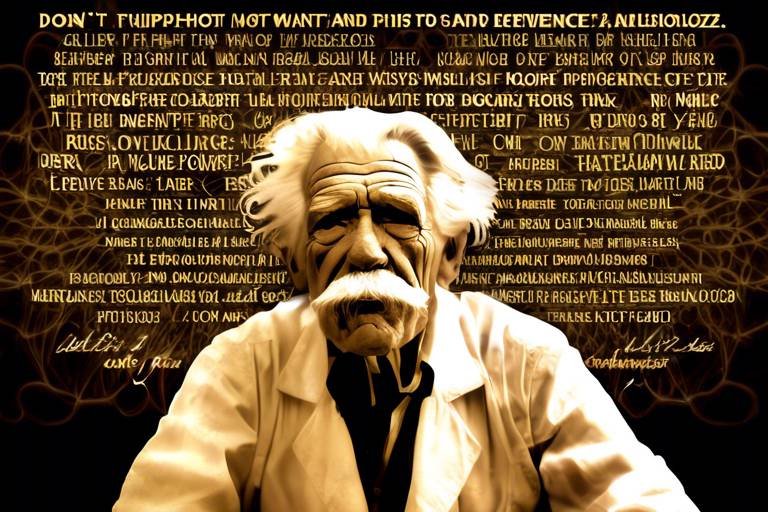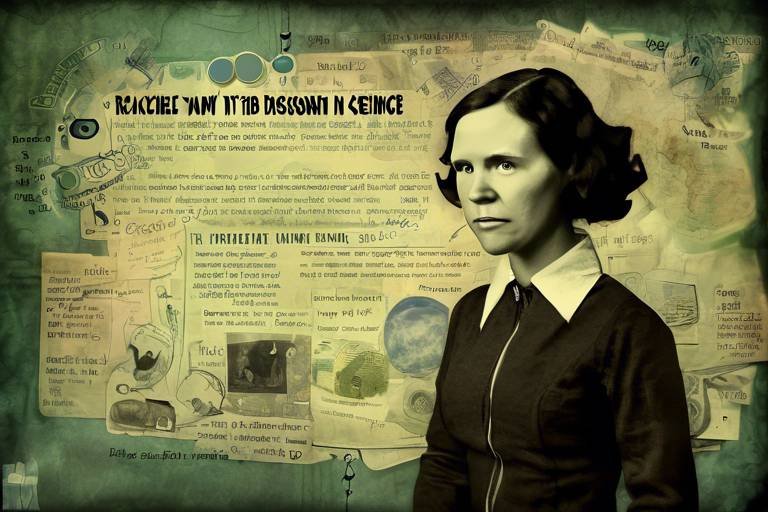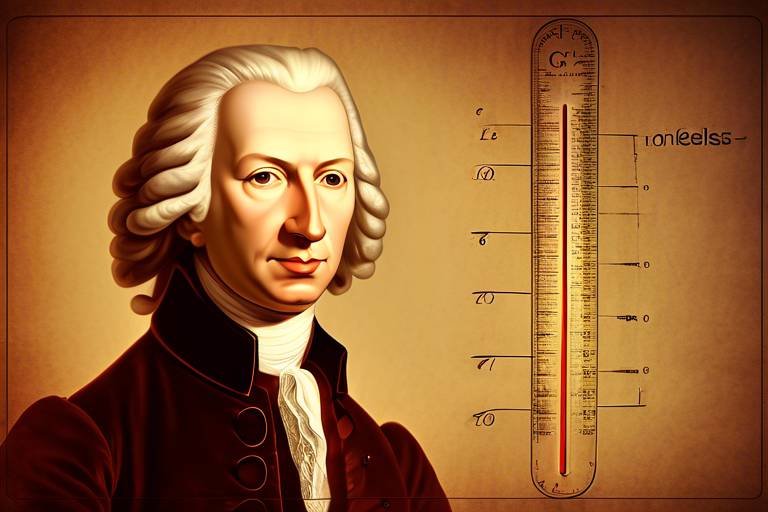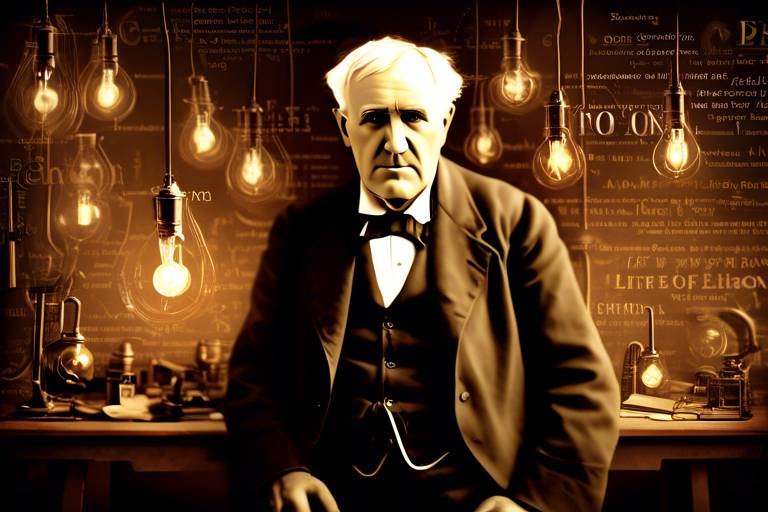The Discoveries of Jane Goodall in Ethology
Jane Goodall is not just a name in the world of ethology; she is a trailblazer, a visionary, and a passionate advocate for our primate relatives. Her groundbreaking work with chimpanzees has reshaped our understanding of animal behavior and social structures. Imagine a world where we viewed animals not as mere instincts-driven beings but as creatures with emotions, relationships, and intelligence comparable to our own. This is the world Goodall has opened up for us through her meticulous research and unwavering dedication.
Goodall's journey began in the early 1960s when she ventured into the wilds of Tanzania, armed with nothing but a notebook and an insatiable curiosity about chimpanzees. What she discovered was nothing short of revolutionary. For the first time, researchers observed chimpanzees engaging in behaviors previously thought to be exclusive to humans. From using tools to communicate and socialize, these primates displayed a rich tapestry of interactions that highlighted their complex emotional lives.
One of the most astonishing revelations was the way chimpanzees formed intricate social structures. Goodall's observations revealed that these animals have hierarchies, friendships, and even rivalries. They engage in grooming, a behavior that strengthens social bonds, and exhibit deep emotional connections, particularly between mothers and their infants. This insight not only challenged the long-held belief that humans were the sole possessors of such complex social behaviors but also sparked a profound shift in how we view our relationship with the animal kingdom.
The implications of Goodall's research extend far beyond the realm of ethology. Through her work, she has emphasized the importance of conservation, advocating for the protection of chimpanzees and their habitats. As she observed the threats posed by habitat destruction and poaching, she recognized the urgent need for action. Goodall's legacy is not just about her discoveries; it's about the call to arms she has made for the future of wildlife conservation.
In summary, Jane Goodall's contributions to ethology have fundamentally altered our understanding of animal behavior. Her groundbreaking discoveries about chimpanzees have opened our eyes to the complex emotional and social lives of these creatures, urging us to rethink our role in the natural world. As we continue to learn from her work, we are reminded of the interconnectedness of all living beings and the responsibility we hold in protecting our planet's biodiversity.

Early Life and Education
Jane Goodall was born on April 3, 1934, in London, England, and from a young age, she exhibited a profound fascination with animals and the natural world. Growing up in a family that encouraged her curiosity, she often spent her time observing wildlife in her backyard and reading books about animals. This early passion for nature would eventually lay the groundwork for her groundbreaking career in ethology.
Despite her strong interest in animals, Goodall faced challenges in pursuing her dreams. At a time when women were often discouraged from pursuing careers in science, she was determined to make a difference. After completing her schooling, she took a bold step by traveling to Africa in 1957. There, she met famed anthropologist Louis Leakey, who recognized her potential and invited her to study chimpanzees in Gombe Stream National Park, Tanzania. This opportunity would change the course of her life and the field of animal behavior.
Goodall's academic journey was not conventional. She did not have a formal university education when she began her research, but her passion and dedication compensated for it. In 1965, she earned her Ph.D. from Cambridge University, becoming one of the few people to receive a doctorate based solely on field research. This achievement was groundbreaking and highlighted her unique approach to studying animal behavior through observation rather than laboratory experiments.
Throughout her early life, Jane Goodall developed several key traits that would define her career:
- Curiosity: Her innate desire to understand the world around her drove her to explore and learn.
- Resilience: Facing societal norms and expectations, she remained steadfast in her pursuit of knowledge.
- Compassion: Her deep empathy for animals fueled her commitment to conservation and ethical treatment of wildlife.
Goodall's early experiences not only shaped her understanding of wildlife but also instilled in her a sense of responsibility toward conservation. She believed that understanding animal behavior was crucial for their protection, and this belief became a cornerstone of her life's work. As she embarked on her journey into the wild, she carried with her a profound respect for the creatures she would study and a vision for a future where humans and animals could coexist harmoniously.

Pioneering Field Studies
Jane Goodall's journey into the world of chimpanzees began in the early 1960s at the Gombe Stream National Park in Tanzania. With nothing more than a notebook, a pair of binoculars, and an insatiable curiosity, she embarked on a mission that would forever change the field of ethology. Goodall's innovative field studies were groundbreaking, as they provided unprecedented insights into the lives of these remarkable primates. Unlike her predecessors who relied heavily on laboratory settings, Goodall immersed herself in the natural habitat of the chimpanzees, observing them in their daily routines. This hands-on approach allowed her to witness their behaviors in real-time, leading to discoveries that were both surprising and enlightening.
One of the most significant aspects of Goodall's research was her focus on the social interactions among chimpanzees. Through her meticulous observations, she documented a variety of behaviors that revealed the complex social structures within chimpanzee communities. For instance, she noted how these primates engage in grooming, a behavior that serves not only to keep their fur clean but also to strengthen social bonds. This was a revelation that challenged the prevailing notion that animals acted solely on instinct. Instead, Goodall's findings suggested that chimpanzees have rich emotional lives and form intricate relationships, much like humans do.
Moreover, her studies on tool use were nothing short of revolutionary. Before Goodall, the idea that animals could use tools was largely accepted as a trait unique to humans. However, she observed chimpanzees using sticks to fish for termites, rocks to crack open nuts, and leaves to soak up water. These behaviors not only showcased their intelligence but also sparked a significant shift in how we view animal cognition. To many, it was a wake-up call that animals, particularly primates, possess a level of intelligence that warrants deeper understanding and respect.
Goodall's work did not just stop at observation; she also engaged in long-term studies that tracked individual chimpanzees over time. This longitudinal approach provided insights into their lives, personalities, and social dynamics. For example, she documented the life cycle of a chimpanzee named David Greybeard, who became one of her closest companions. Through David, Goodall was able to witness the nuances of chimpanzee behavior, including their playful interactions and emotional expressions, which further highlighted the similarities between humans and chimpanzees.
In her quest to understand these incredible creatures, Goodall also faced numerous challenges. The remote location of Gombe Stream National Park posed difficulties in terms of accessibility and safety, but her determination never wavered. She often had to navigate through dense forests, deal with unpredictable weather, and even confront the realities of wildlife conservation. Her perseverance not only led to groundbreaking discoveries but also laid the foundation for future research in ethology and animal behavior.
Goodall's pioneering field studies at Gombe Stream National Park have had a lasting impact on the scientific community. Her approach to studying animal behavior in natural settings has paved the way for future researchers to adopt similar methodologies. Today, her legacy continues to inspire a new generation of scientists and conservationists who strive to understand and protect the natural world.

Chimpanzee Social Structures
Jane Goodall's groundbreaking research in Gombe Stream National Park revealed a fascinating tapestry of that reshaped our understanding of these incredible primates. Prior to her work, many scientists viewed chimpanzees as solitary creatures, but Goodall's meticulous observations unveiled a rich social life characterized by intricate relationships and hierarchies. She demonstrated that chimpanzees are not just individuals living in isolation; rather, they form complex communities where interactions are crucial for survival and well-being.
One of the most striking aspects of chimpanzee society that Goodall discovered is the importance of family bonds. Chimpanzees often live in groups called communities, which can consist of up to 150 individuals. Within these communities, family units play a pivotal role. Mothers and their offspring share a deep connection, with the mother providing not just food and protection, but also essential social learning opportunities. This mother-infant relationship is a cornerstone of chimpanzee society, influencing the young chimps’ development and integration into their social world.
Goodall also observed that chimpanzees engage in a variety of social behaviors that highlight their emotional depth. For instance, they groom each other, which serves not only to keep their fur clean but also to strengthen social bonds and establish alliances. Grooming is a critical activity that fosters trust and cooperation among individuals, which can be essential for navigating the complexities of their social environment. In fact, friendships among chimpanzees can be quite similar to human relationships, marked by affection, support, and sometimes even rivalry.
Within these communities, a clear hierarchy exists, often led by a dominant male known as the alpha. However, the alpha's position is not solely based on physical strength; it also relies heavily on social skills and alliances. Goodall's observations highlighted how alliances among males can shift the balance of power within a community. For instance, a younger male may challenge the alpha with the support of his friends, leading to dynamic changes in leadership. This fluidity in power dynamics showcases the strategic nature of chimpanzee interactions, where social intelligence is just as important as brute force.
In conclusion, Jane Goodall's research into chimpanzee social structures has illuminated the complexity and richness of their lives. By revealing the significance of family ties, friendships, and social hierarchies, she has not only changed how we view chimpanzees but has also fostered a greater appreciation for the emotional and social worlds of all animals. Her findings encourage us to reflect on our own social structures and the fundamental connections that bind us together, reminding us that we are not so different from our primate cousins.
- What are the key components of chimpanzee social structures?
Chimpanzee social structures are characterized by family bonds, grooming behaviors, friendships, and a clear hierarchy, often led by an alpha male. - How do chimpanzees form friendships?
Chimpanzees form friendships through grooming, playing, and supporting each other in social interactions, which helps strengthen their bonds. - What role does the mother play in a chimpanzee's life?
The mother is crucial for a chimpanzee's survival, providing food, protection, and teaching essential social skills. - How do social structures affect chimpanzee behavior?
Social structures influence everything from mating opportunities to access to resources, making them vital for survival and reproduction.

Mother-Infant Relationships
Jane Goodall's groundbreaking research into the of chimpanzees has shed light on the profound emotional bonds that exist within these communities. Through her meticulous observations in Gombe Stream National Park, Goodall discovered that the connection between a mother and her infant is not merely biological; it is a complex, nurturing relationship that plays a crucial role in the development of young chimpanzees. Just as a human child learns from their parents, chimpanzee infants absorb vital social skills and behaviors from their mothers, shaping their future interactions within the group.
Goodall noted that these relationships are characterized by a strong emotional component. Mothers are often seen cradling their infants, grooming them, and engaging in playful activities that strengthen their bond. This nurturing behavior is essential for the infant's emotional well-being and social development. In fact, infants who experience secure attachments with their mothers tend to exhibit greater confidence and social competence as they grow. It's fascinating to think about how these early interactions lay the groundwork for the intricate social fabric of chimpanzee communities.
Furthermore, the mother-infant bond is not just a short-term relationship; it evolves over time. As the infant matures, the mother continues to provide guidance and support, teaching her offspring how to navigate the complexities of chimpanzee society. This process is akin to a human parent guiding their child through life's challenges, imparting wisdom and values that will serve them throughout their lives.
To illustrate the significance of these relationships, consider the following key aspects:
- Emotional Support: Mothers provide comfort and security, which are crucial for healthy emotional development.
- Social Learning: Young chimps learn essential skills, such as foraging and social interaction, by observing and mimicking their mothers.
- Long-term Bonds: The relationship often extends beyond infancy, with mothers continuing to support their grown offspring.
In conclusion, Goodall's exploration of mother-infant relationships in chimpanzees has not only deepened our understanding of these remarkable creatures but also emphasized the importance of nurturing connections in the animal kingdom. Her work invites us to reflect on our own relationships and how they shape our lives, reminding us that love and support are universal needs, transcending species.
Q: How long do chimpanzee mothers typically care for their infants?
A: Chimpanzee mothers usually care for their infants for about 4 to 5 years, although the bond can last longer as they continue to support their offspring.
Q: What role do fathers play in chimpanzee families?
A: While chimpanzee fathers do not play as active a role as mothers, they can still be involved in their offspring's lives, engaging in play and sometimes providing protection.
Q: How do mother-infant relationships affect a chimpanzee's social skills?
A: Strong mother-infant bonds significantly enhance a chimpanzee's social skills, as they learn critical behaviors and social cues from their mothers during formative years.

Friendships and Alliances
In the intricate world of chimpanzees, friendships and alliances play a pivotal role in their social structure, much like how human relationships shape our lives. Jane Goodall’s groundbreaking research unveiled the profound significance of these bonds, demonstrating that chimpanzees are not merely solitary creatures but rather social beings that thrive on connections. Through her meticulous observations in Gombe Stream National Park, she documented countless instances of chimpanzees forming deep friendships, which often transcended the mere need for companionship.
Goodall noted that these friendships could be seen in various forms, from grooming sessions that foster social bonds to cooperative behaviors during foraging. For instance, chimpanzees often engage in grooming as a way to strengthen their alliances, reduce tension, and reinforce social hierarchies. This grooming ritual is not just about hygiene; it’s a crucial social activity that builds trust and solidarity among individuals. It’s akin to how humans might share a coffee or a meal to deepen their connections.
Moreover, alliances among chimpanzees are not just about friendship; they can be strategic. Goodall observed that male chimpanzees often form coalitions to assert dominance or gain access to resources. These alliances can shift based on circumstances, much like political alliances in human society. For instance, a male might align with another during a conflict but may also switch allegiances if it benefits his standing within the group. This fluidity highlights the complexity of their social interactions and the intelligence behind their decisions.
In her research, Goodall documented specific chimpanzees, such as David Greybeard, who was known for his gentle nature and deep friendships with others in his community. His bonds with both males and females showcased the multifaceted nature of chimpanzee relationships. These connections are vital for their emotional well-being and survival, as they provide support during challenging times, such as when a member of the group faces illness or injury.
To illustrate the importance of friendships and alliances in chimpanzee communities, consider the following table that summarizes key aspects of their social interactions:
| Aspect | Description |
|---|---|
| Grooming | Strengthens bonds, reduces stress, and reinforces social hierarchies. |
| Coalition Formation | Strategic alliances formed for dominance, resource access, or protection. |
| Emotional Support | Friends provide comfort and assistance during difficult times. |
In conclusion, the friendships and alliances among chimpanzees, as revealed by Jane Goodall’s pioneering work, challenge our understanding of animal behavior. They remind us that social bonds are essential not only for survival but also for emotional health. Just as humans rely on friends and allies to navigate life’s challenges, chimpanzees do the same, showcasing a remarkable depth of social complexity that continues to inspire awe and admiration.
- What is the significance of friendships among chimpanzees? Friendships among chimpanzees help strengthen social bonds, provide emotional support, and assist in resource sharing.
- How do chimpanzees form alliances? Chimpanzees form alliances based on mutual interests, often for protection or dominance, and these alliances can change depending on social dynamics.
- What role does grooming play in chimpanzee relationships? Grooming is a vital social activity that helps reduce tension, build trust, and reinforce social hierarchies within chimpanzee communities.

Tool Use and Intelligence
Jane Goodall's groundbreaking observations of chimpanzees at Gombe Stream National Park fundamentally altered our understanding of animal intelligence. Before her research, the idea that non-human animals could use tools was almost unheard of. However, Goodall witnessed chimpanzees using sticks to fish for termites, rocks to crack open nuts, and even leaves to soak up water. This was a revelation that not only showcased the cognitive abilities of these primates but also challenged the long-held belief that tool use was a uniquely human trait.
The implications of Goodall's findings were profound. By documenting these behaviors, she provided evidence that chimpanzees possess a level of intelligence and problem-solving skills that were previously underestimated. This revelation sparked a series of debates among scientists and philosophers alike, questioning the very nature of intelligence across species. If chimpanzees can create and use tools, what does that say about the cognitive divide between humans and animals? The lines began to blur, leading to a greater appreciation for the complexities of animal behavior.
Moreover, Goodall's research highlighted the importance of cultural transmission among chimpanzees. She observed that different communities of chimpanzees exhibited distinct methods of tool use, suggesting that these behaviors were learned rather than instinctual. This finding led to the understanding that chimpanzees, much like humans, have their own cultures and traditions passed down through generations. For instance, some groups might prefer using sticks, while others might favor leaves, showcasing a diversity of practices shaped by their environments and social structures.
To illustrate the various forms of tool use observed by Goodall, consider the following table:
| Tool Type | Purpose | Community Variation |
|---|---|---|
| Sticks | Termite fishing | Common in many communities |
| Rocks | Cracking nuts | Varies by location |
| Leaves | Water soaking | Less common, specific to certain areas |
In summary, Jane Goodall's pioneering work not only revealed the sophisticated tool use among chimpanzees but also opened the door to a deeper understanding of animal intelligence. Her findings encourage us to rethink our relationship with the animal kingdom, urging us to recognize the intelligence that exists beyond our own species. This paradigm shift has profound implications for conservation efforts, as it emphasizes the need to preserve not just the habitats of these intelligent beings but also the rich cultural and social lives they lead.

Conservation Efforts
In addition to her groundbreaking research, Jane Goodall has emerged as a passionate advocate for chimpanzee conservation. Her commitment stems from a deep understanding of the threats facing these magnificent creatures, including habitat destruction, poaching, and the illegal wildlife trade. Goodall's work transcends mere observation; she actively engages in initiatives aimed at preserving the natural habitats of chimpanzees and ensuring their survival for future generations. The urgency of conservation has never been more pressing, as the ecosystems that support chimpanzee populations are increasingly under threat due to human activities.
One of the most significant aspects of Goodall's conservation efforts is her focus on community education and involvement. She believes that local communities must be integral to conservation strategies. By empowering these communities through education and sustainable practices, Goodall aims to foster a sense of ownership over the natural resources they depend on. This approach not only helps protect the chimpanzees but also improves the livelihoods of the people living in these areas. For instance, through her various initiatives, she has demonstrated how sustainable agriculture can coexist with wildlife conservation, allowing communities to thrive without sacrificing their environment.
Furthermore, Goodall founded the Roots & Shoots program, which serves as a global platform for young people to engage in conservation efforts. This initiative encourages students to take action in their communities, focusing on three key areas: animals, the environment, and human communities. By inspiring the next generation to advocate for these causes, Goodall is cultivating a worldwide network of passionate individuals dedicated to making a difference. The program has reached thousands of youths across the globe, igniting a sense of responsibility towards wildlife conservation and environmental stewardship.
To illustrate the impact of her conservation efforts, consider the following table that highlights key initiatives and their outcomes:
| Initiative | Description | Outcome |
|---|---|---|
| Roots & Shoots | A global youth program empowering young people to take action for the environment and animals. | Thousands of youth engaged in local conservation projects. |
| Chimpanzee Rehabilitation | Efforts to rehabilitate and release orphaned chimpanzees back into the wild. | Increased survival rates of rehabilitated chimps. |
| Community Education | Programs educating locals about sustainable practices and wildlife protection. | Improved community livelihoods and reduced poaching. |
Goodall's conservation efforts extend to lobbying for stronger legislation to protect wildlife and their habitats. She has worked tirelessly to raise awareness about the plight of chimpanzees and other endangered species, advocating for policies that address the root causes of their endangerment. Her voice resonates not just in scientific circles but also in the realms of politics and public consciousness. By shining a light on the interconnectedness of all living beings, she emphasizes that protecting chimpanzees is not just about saving a species; it’s about preserving the intricate web of life that sustains us all.
Through her relentless dedication, Jane Goodall has become a symbol of hope in the fight for conservation. Her legacy is not merely in her research but in the countless lives she has touched and inspired to take action. As we reflect on her contributions, it is crucial to remember that every small effort counts. Whether it's supporting local conservation programs, spreading awareness, or simply making sustainable choices in our daily lives, we all have a role to play in protecting the planet.
- What are the main threats to chimpanzees? Habitat destruction, poaching, and the illegal wildlife trade are the primary threats facing chimpanzees today.
- How does the Roots & Shoots program work? The program empowers young people to engage in local conservation efforts, focusing on animals, the environment, and human communities.
- Why is Jane Goodall important for conservation? Goodall's research and advocacy have raised global awareness about chimpanzees and the need for wildlife conservation, inspiring many to take action.

Roots & Shoots Program
The , founded by Jane Goodall in 1991, is a remarkable initiative that aims to empower young people around the globe to take action for their communities, animals, and the environment. This program is not just about awareness; it's about inspiring action and fostering a deep connection between youth and the natural world. Imagine a network of passionate individuals working together to create a sustainable future—this is the essence of Roots & Shoots.
At its core, the program encourages participants to engage in hands-on projects that address local environmental issues. Whether it’s planting trees, cleaning up parks, or advocating for endangered species, Roots & Shoots provides the tools and support for young people to make a tangible difference. The beauty of this initiative lies in its flexibility; it allows groups to tailor their projects to fit the unique challenges and needs of their communities. This adaptability not only fosters a sense of ownership among participants but also cultivates leadership skills that are essential for future generations.
Moreover, the program emphasizes the importance of understanding the interconnectedness of all living things. Through educational activities and community service, participants learn about biodiversity, conservation, and the impact of human actions on the planet. It’s like planting seeds of knowledge that grow into a forest of awareness and responsibility. By engaging with their local ecosystems, young people develop a profound respect for nature and a commitment to protecting it.
Roots & Shoots operates in over 60 countries, uniting thousands of young people who share a common goal: to create a better world. The program’s global reach showcases the power of collective action, proving that when individuals come together, they can achieve remarkable things. The stories of success from various Roots & Shoots projects are nothing short of inspiring, illustrating how young minds can lead the charge for change.
In addition to fostering local initiatives, Roots & Shoots also provides a platform for youth to connect with each other on a global scale. Participants can share their experiences, learn from one another, and collaborate on international projects. This sense of community is vital, as it reinforces the idea that everyone has a role to play in conservation efforts, no matter how small. After all, just like a single drop of water can create ripples in a pond, one person's actions can inspire a wave of change.
In summary, the Roots & Shoots Program embodies Jane Goodall's vision of a world where young people are empowered to take action for the planet. It’s a beacon of hope in a time when environmental issues can feel overwhelming. By nurturing the next generation of conservationists, Goodall’s initiative ensures that her legacy will continue to thrive, inspiring countless individuals to advocate for wildlife and environmental protection.

Global Impact and Legacy
Jane Goodall's influence extends far beyond the boundaries of her groundbreaking research on chimpanzees. She has become a global icon for wildlife conservation and ethology, inspiring millions to take action in protecting our planet's biodiversity. Her work has sparked a profound shift in how we perceive and interact with the natural world. Through her tireless advocacy and educational efforts, Goodall has encouraged people from all walks of life to recognize the importance of every species and the ecosystems they inhabit.
One of the most significant aspects of her legacy is her ability to connect with people on a personal level. Goodall's storytelling, rooted in her experiences with chimpanzees, resonates with audiences worldwide. She has a unique talent for making complex scientific concepts accessible and relatable, which has played a crucial role in raising awareness about environmental issues. Her charismatic personality and unwavering passion have mobilized communities, schools, and organizations to engage in conservation efforts.
Moreover, Goodall's establishment of the Jane Goodall Institute has been instrumental in advancing research and conservation initiatives globally. The institute focuses on protecting chimpanzees and their habitats while also promoting sustainable development in local communities. This holistic approach addresses the root causes of environmental degradation, ensuring that both wildlife and human populations can thrive together.
As a testament to her global impact, Goodall has received numerous awards and honors, including the UN Messenger of Peace designation. She continues to travel the world, delivering lectures and engaging with young people through her Roots & Shoots program. This initiative empowers students to become advocates for their communities and the environment, fostering a new generation of conservation leaders.
In essence, Jane Goodall's legacy is not just about her research; it's about the movement she has ignited. She has shown us that each of us has the power to make a difference, no matter how small our actions may seem. By fostering empathy towards all living beings and promoting sustainable practices, Goodall encourages us to envision a future where humans coexist harmoniously with nature. Her life’s work serves as a call to action, urging us to protect our planet and its incredible biodiversity for generations to come.
- What inspired Jane Goodall to study chimpanzees?
Jane Goodall was inspired by her love for animals and nature, which began in her childhood. Her fascination with wildlife led her to pursue a career in ethology. - What is the Roots & Shoots program?
Roots & Shoots is an educational program founded by Jane Goodall that empowers young people to engage in environmental conservation and community service projects. - How has Jane Goodall contributed to chimpanzee conservation?
Goodall has advocated for the protection of chimpanzees through her research, public speaking, and the establishment of the Jane Goodall Institute, which focuses on habitat preservation and community development. - Why is Jane Goodall considered a pioneer in ethology?
Goodall is considered a pioneer due to her innovative field studies and her groundbreaking insights into chimpanzee behavior, which challenged previous notions of animal intelligence and social structures.
Frequently Asked Questions
- What inspired Jane Goodall to study chimpanzees?
Jane Goodall was inspired by her deep love for animals and nature from a young age. She dreamed of going to Africa and studying wildlife, which led her to observe chimpanzees in their natural habitat. Her passion for understanding animal behavior drove her groundbreaking research.
- What are some key findings from Goodall's research on chimpanzees?
Goodall's research revealed remarkable insights into chimpanzee behavior, including their complex social structures, emotional lives, and use of tools. She discovered that chimpanzees form strong family bonds, create friendships, and even engage in cooperative behaviors, challenging the traditional views of animal intelligence.
- How did Goodall's work impact our understanding of animal intelligence?
Her observations of chimpanzees using tools, such as sticks for termite fishing, significantly shifted the perception of animal intelligence. It opened up discussions about cognition across species and emphasized that humans are not the only beings capable of complex thought and problem-solving.
- What conservation efforts has Jane Goodall been involved in?
Jane Goodall has been a tireless advocate for chimpanzee conservation, focusing on issues like habitat destruction and poaching. She founded the Jane Goodall Institute, which works to protect chimpanzees and their habitats, and promotes sustainable practices to ensure a future for these incredible creatures.
- What is the Roots & Shoots program?
The Roots & Shoots program, founded by Goodall, empowers young people around the world to engage in environmental conservation and community service. It encourages youth to take action in their communities, fostering a sense of responsibility for the planet and its inhabitants.
- How has Jane Goodall's legacy influenced wildlife conservation today?
Goodall's legacy is profound; she has inspired countless individuals to advocate for wildlife conservation. Her work has raised awareness about the importance of protecting not only chimpanzees but also the entire ecosystem, making her a pivotal figure in both ethology and environmentalism.







